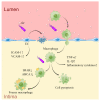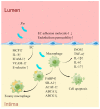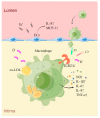The Roles of Periodontal Bacteria in Atherosclerosis
- PMID: 37629042
- PMCID: PMC10454115
- DOI: 10.3390/ijms241612861
The Roles of Periodontal Bacteria in Atherosclerosis
Abstract
Atherosclerosis (AS) is an inflammatory vascular disease that constitutes a major underlying cause of cardiovascular diseases (CVD) and stroke. Infection is a contributing risk factor for AS. Epidemiological evidence has implicated individuals afflicted by periodontitis displaying an increased susceptibility to AS and CVD. This review concisely outlines several prevalent periodontal pathogens identified within atherosclerotic plaques, including Porphyromonas gingivalis, Aggregatibacter actinomycetemcomitans, and Fusobacterium nucleatum. We review the existing epidemiological evidence elucidating the association between these pathogens and AS-related diseases, and the diverse mechanisms for which these pathogens may engage in AS, such as endothelial barrier disruption, immune system activation, facilitation of monocyte adhesion and aggregation, and promotion of foam cell formation, all of which contribute to the progression and destabilization of atherosclerotic plaques. Notably, the intricate interplay among bacteria underscores the complex impact of periodontitis on AS. In conclusion, advancing our understanding of the relationship between periodontal pathogens and AS will undoubtedly offer invaluable insights and potential therapeutic avenues for the prevention and management of AS.
Keywords: Aggregatibacter actinomycetemcomitans; CVD; Fusobacterium nucleatum; Porphyromonas gingivalis; atherosclerosis; instability; periodontal pathogens; plaque.
Conflict of interest statement
The authors declare no conflict of interest.
Figures




Similar articles
-
[Research progress of correlation between periodontal pathogens and systemic diseases].Nan Fang Yi Ke Da Xue Xue Bao. 2020 May 30;40(5):759-764. doi: 10.12122/j.issn.1673-4254.2020.05.24. Nan Fang Yi Ke Da Xue Xue Bao. 2020. PMID: 32897213 Free PMC article. Review. Chinese.
-
Role of periodontal pathogens in atherosclerotic plaque development and progression: An overview.Acta Microbiol Immunol Hung. 2023 Nov 16;70(4):272-277. doi: 10.1556/030.2023.02145. Print 2023 Dec 7. Acta Microbiol Immunol Hung. 2023. PMID: 37975913 Review.
-
Periodontal pathogens invade gingiva and aortic adventitia and elicit inflammasome activation in αvβ6 integrin-deficient mice.Infect Immun. 2015 Dec;83(12):4582-93. doi: 10.1128/IAI.01077-15. Epub 2015 Sep 14. Infect Immun. 2015. PMID: 26371120 Free PMC article.
-
Influence of a triclosan toothpaste on periodontopathic bacteria and periodontitis progression in cardiovascular patients: a randomized controlled trial.J Periodontal Res. 2017 Feb;52(1):61-73. doi: 10.1111/jre.12369. Epub 2016 Mar 2. J Periodontal Res. 2017. PMID: 26932733 Clinical Trial.
-
Detection of eight periodontal microorganisms and distribution of Porphyromonas gingivalis fimA genotypes in Chinese patients with aggressive periodontitis.J Periodontol. 2014 Jan;85(1):150-9. doi: 10.1902/jop.2013.120677. Epub 2013 May 7. J Periodontol. 2014. PMID: 23646850
Cited by
-
Membrane vesicles from Red Complex bacteria: key players in oral pathogenesis, immune disruption, systemic diseases, and therapeutic insights.Front Oral Health. 2025 Jul 28;6:1607931. doi: 10.3389/froh.2025.1607931. eCollection 2025. Front Oral Health. 2025. PMID: 40791780 Free PMC article. Review.
-
Polybacterial Periodontal Infection Alters oxidative and Inflammatory Biomarkers in Primary Human Aortic Endothelial Cell (pHAECs).J Pharm Pharmacol Res. 2025;9(2):45-53. doi: 10.26502/fjppr.0108. Epub 2025 Apr 19. J Pharm Pharmacol Res. 2025. PMID: 40370477 Free PMC article.
-
An Assessment of Periodontal Status and Oral Hygiene in Patients with Hypertension in the South-West Region of Romania.Biomedicines. 2025 Mar 12;13(3):696. doi: 10.3390/biomedicines13030696. Biomedicines. 2025. PMID: 40149672 Free PMC article.
-
Unveiling the Molecular Crosstalk Between Periodontal and Cardiovascular Diseases: A Systematic Review.Dent J (Basel). 2025 Feb 25;13(3):98. doi: 10.3390/dj13030098. Dent J (Basel). 2025. PMID: 40136726 Free PMC article. Review.
-
The Role of Systemic Health Indicators, Including C-Reactive Protein and eGFR, in Predicting Periodontal Disease: A Longitudinal Study.Int J Mol Sci. 2025 Jan 16;26(2):741. doi: 10.3390/ijms26020741. Int J Mol Sci. 2025. PMID: 39859455 Free PMC article.
References
-
- Murray C.J., Vos T., Lozano R., Naghavi M., Flaxman A.D., Michaud C., Ezzati M., Shibuya K., Salomon J.A., Abdalla S., et al. Disability-adjusted life years (DALYs) for 291 diseases and injuries in 21 regions, 1990–2010: A systematic analysis for the Global Burden of Disease Study 2010. Lancet. 2012;380:2197–2223. doi: 10.1016/S0140-6736(12)61689-4. - DOI - PubMed
Publication types
MeSH terms
Grants and funding
- 82101025/National Natural Science Foundation of China for Young Scientists
- 82030070/National Natural Science Foundation of China for Key Program Projects
- F016020042200100506/Key project of Clinical Research Fund of Union Hospital, Tongji Medical College, HUST
- COS-B2021-01/Young talents training program of Orthodontic Committee of Chinese Stomatological Association
LinkOut - more resources
Full Text Sources
Medical
Research Materials

